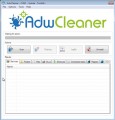The go.ppixelm.com is a web page that created to show advertisements or reroute to other ‘ad’ sites. Its appearance in your web browser could mean that your PC system is infected with adware (sometimes called ‘ad-supported’ software). This type of dangerous applications does not delete files or infect them, but such as a virus can modify machine settings like the home page, newtab page and search provider by default and download and install malicious extensions that generates lots of popup ads. All the time, while the adware is running, your browser will be fill with annoying advertisements. Moreover, this ad supported software will be able to collect a huge number of information about you, everything related to what are you doing on the Net. Thus, it is clear that the presence of adware on your computer is not desirable, and you need to clean up your system in order to get rid of go.ppixelm.com pop-up ads as soon as possible.
![]()
The adware can change the settings of the Google Chrome, IE, Firefox and Microsoft Edge, but often that a malicious software like this can also infect all types of internet browsers by changing their desktop shortcuts. Thus forcing the user each time launch the internet browser to see go.ppixelm.com unwanted ads.
Technically, the ad-supported software is not a virus, but it does bad things, it generates a large number of ads, hindering or completely blocking the work in the web-browser. It may install other unknown and unwanted software without your permission, force you to visit malicious sites. Moreover, a browser hijacker can be additionally installed on to your PC with the adware. Once installed, it will modify your home page with an unwanted web site.
Instructions, which is shown below, will allow you to clean your system from the adware as well as remove go.ppixelm.com unwanted ads from the Chrome, IE, FF and MS Edge and other browsers.
How does go.ppixelm.com advertisements get installed onto computer
The ad-supported software actively distributed with free applications, as a part of the installer of the software. Therefore, it is very important, when installing an unknown software even downloaded from known or big hosting web-site, read the Terms of use and the Software license, as well as to select the Manual, Advanced or Custom install mode. In this mode, you can disable the install of unneeded modules and software and protect your PC from the adware infection. Unfortunately, most users when installing unknown software, simply click Next button, and don’t read any information that the free programs displays them during its installation. This leads to the fact that the internet browser starts to display lots of the go.ppixelm.com ads.
How to manually remove go.ppixelm.com
The following instructions is a step-by-step guide, which will help you manually remove go.ppixelm.com ads from the Chrome, Internet Explorer, Mozilla Firefox and MS Edge.
- Remove suspicious and unknown software by using Windows Control Panel
- Disinfect the browser’s shortcuts to get rid of go.ppixelm.com redirect
- Remove go.ppixelm.com pop-up ads from Chrome
- Delete go.ppixelm.com redirect from FF
- Remove go.ppixelm.com redirect from Microsoft Internet Explorer
- Get rid of unwanted Scheduled Tasks
Delete suspicious and unknown software by using Windows Control Panel
First, you should try to identify and delete the application that causes the appearance of annoying advertisements and web browser redirect to unwanted pages, using the ‘Uninstall a program’ which is located in the ‘Control panel’.
Windows 8, 8.1, 10
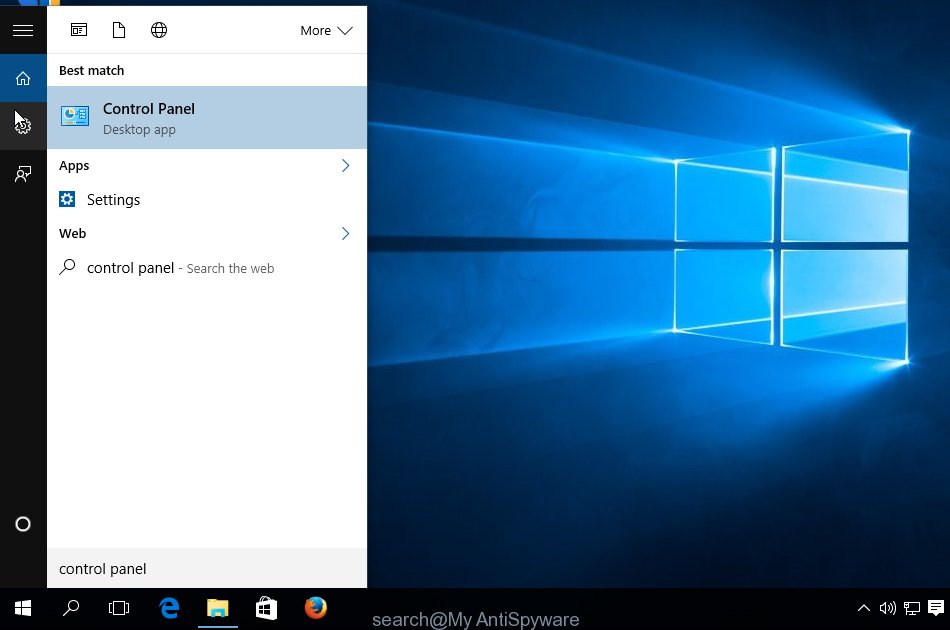 When the ‘Control Panel’ opens, press the ‘Uninstall a program’ under Programs category as shown in the following image.
When the ‘Control Panel’ opens, press the ‘Uninstall a program’ under Programs category as shown in the following image. 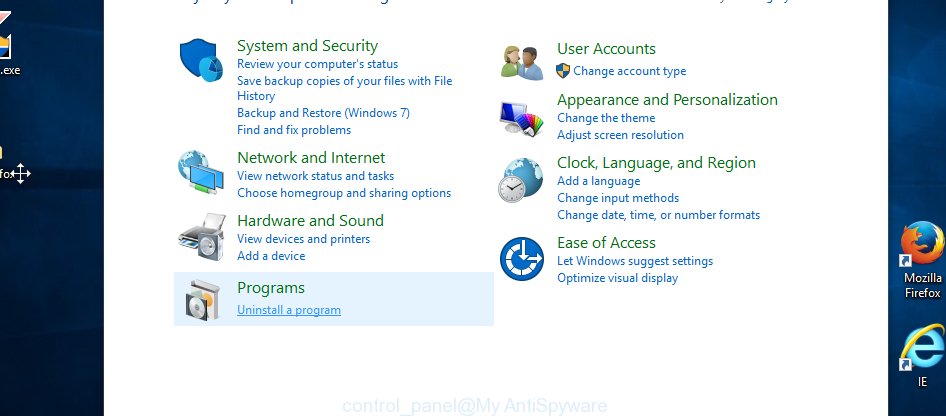 You will see the ‘Uninstall a program’ panel as shown on the screen below.
You will see the ‘Uninstall a program’ panel as shown on the screen below.  Very carefully look around the entire list of installed programs. Most likely, one or more of them are responsible for the browser redirect to annoying go.ppixelm.com ads. If you have many programs installed, you can help simplify the search of malicious programs by sort the list by date of installation. Once you have found a suspicious, unwanted or unused program, right click to it and press ‘Uninstall’.
Very carefully look around the entire list of installed programs. Most likely, one or more of them are responsible for the browser redirect to annoying go.ppixelm.com ads. If you have many programs installed, you can help simplify the search of malicious programs by sort the list by date of installation. Once you have found a suspicious, unwanted or unused program, right click to it and press ‘Uninstall’.
Windows XP, Vista, 7
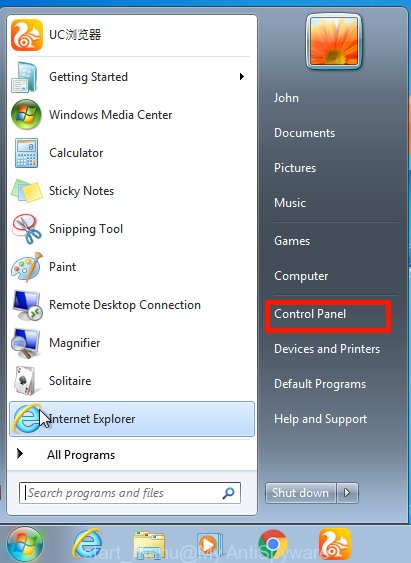 When the Windows ‘Control Panel’ opens, you need to click ‘Uninstall a program’ under ‘Programs’ as shown on the screen below.
When the Windows ‘Control Panel’ opens, you need to click ‘Uninstall a program’ under ‘Programs’ as shown on the screen below. 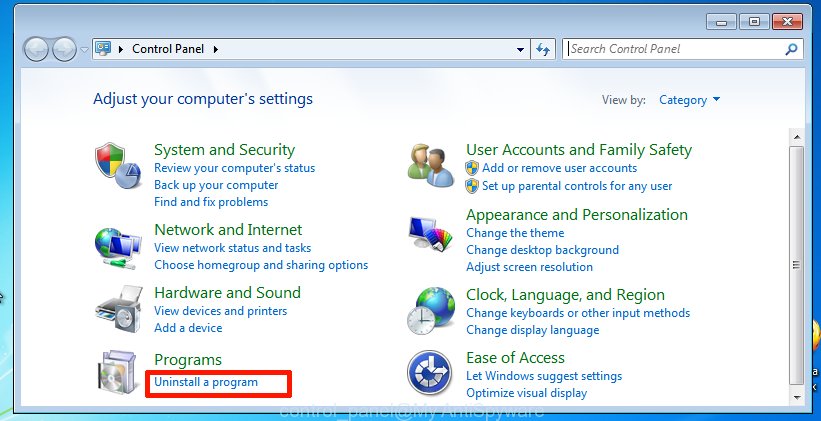 You will see a list of applications installed on your computer. We recommend to sort the list by date of installation to quickly find the programs that were installed last. Most likely they responsibility for the appearance of unwanted pop-up ads and web-browser redirect. If you are in doubt, you can always check the application by doing a search for her name in Google, Yahoo or Bing. When the program, you need to delete, is found, simply click on its name, and then click ‘Uninstall’ as shown on the screen below.
You will see a list of applications installed on your computer. We recommend to sort the list by date of installation to quickly find the programs that were installed last. Most likely they responsibility for the appearance of unwanted pop-up ads and web-browser redirect. If you are in doubt, you can always check the application by doing a search for her name in Google, Yahoo or Bing. When the program, you need to delete, is found, simply click on its name, and then click ‘Uninstall’ as shown on the screen below. 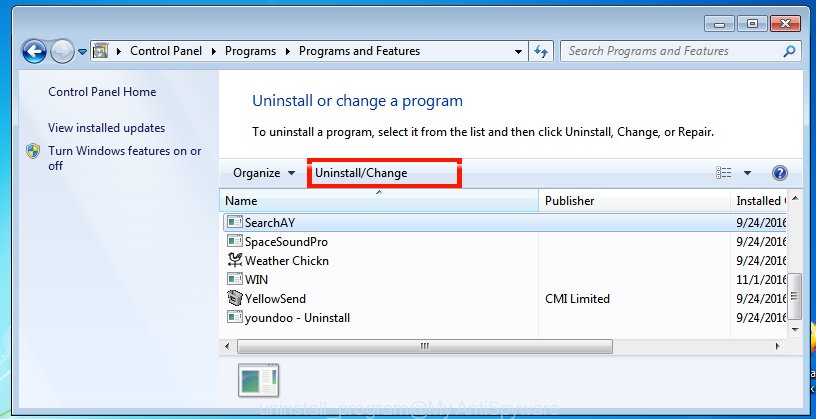
Disinfect the browser’s shortcuts to get rid of go.ppixelm.com redirect
Once installed, the ad supported software may add an argument similar “http://site.address” into the Target property of the desktop shortcut for the Google Chrome, Firefox, IE and Edge. Due to this, every time you open the web-browser, it will open the go.ppixelm.com annoying web-page.
Right click on the browser’s shortcut, click Properties option. On the Shortcut tab, locate the Target field. Click inside, you will see a vertical line – arrow pointer, move it (using -> arrow key on your keyboard) to the right as possible. You will see a text that begins with “http://”. Remove it or everything after .exe. An example, for Google Chrome you should remove everything after chrome.exe.
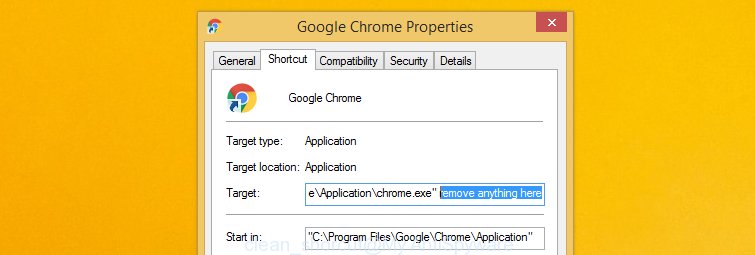
Next, click OK to save changes. You need to clean all web-browser’s shortcuts. So, repeat this step for the Google Chrome, Microsoft Internet Explorer, FF and MS Edge.
Remove go.ppixelm.com pop-up ads from Chrome
Reset Google Chrome settings is a easy way to remove the malware and adware, as well as to restore the web browser’s settings that have been replaced by adware.

- Now launch the Google Chrome and click Menu button (small button in the form of three horizontal stripes).
- It will show the Chrome main menu. Select “Settings” option.
- You will see the Chrome’s settings page. Scroll down and click “Show advanced settings” link.
- Scroll down again and click the “Reset settings” button.
- The Google Chrome will display the reset profile settings page as shown on the screen above.
- Next, press the “Reset” button.
- When this process is complete, your browser’s settings will be restored to their original defaults. This will reset your home page, newtab page and search provider by default.
- To learn more, read the article How to reset Chrome settings to default.
Delete go.ppixelm.com redirect from FF
If the Firefox settings have been changed by the adware, then resetting it to the default state can help you to remove the redirect onto go.ppixelm.com web site.
First, run the FF and press ![]() button. It will show the drop-down menu on the right-part of the browser. Next, click the Help button (
button. It will show the drop-down menu on the right-part of the browser. Next, click the Help button (![]() ) as on the image below.
) as on the image below.

In the Help menu, select the “Troubleshooting Information” option. Another way to open the “Troubleshooting Information” screen – type “about:support” in the web browser address bar and press Enter. It will display the “Troubleshooting Information” page as shown on the image below. In the upper-right corner of this screen, click the “Refresh Firefox” button.

It will open the confirmation dialog box, click the “Refresh Firefox” button. The Firefox will start a procedure to fix your problems that caused by the adware. When it’s finished, click the “Finish” button
Remove go.ppixelm.com redirect from Microsoft Internet Explorer
First, start the Internet Explorer, then click the button in the form of gear (![]() ). It will display the Tools drop-down menu as shown in the following image. Next, click the “Internet Options”.
). It will display the Tools drop-down menu as shown in the following image. Next, click the “Internet Options”.

In the Internet Options window click on the Advanced tab, then click the Reset button. The Internet Explorer will open the “Reset Internet Explorer settings” window like below. Select the “Delete personal settings” check box, then click on “Reset” button.

You will now need to restart your computer for the changes to take effect.
Get rid of unwanted Scheduled Tasks
Once installed, the adware can add a task in to the Windows Task Scheduler Library. Due to this, every time when you open your computer, it will open go.ppixelm.com unwanted site. So, you need to check the Task Scheduler Library and get rid of all tasks that have been created by adware.
Press Windows and R keys on your keyboard at the same time. It will open a prompt which titled with Run. In the text field, type “taskschd.msc” (without the quotes) and click OK. Task Scheduler window opens. In the left-hand side, click “Task Scheduler Library”, as shown on the screen below.
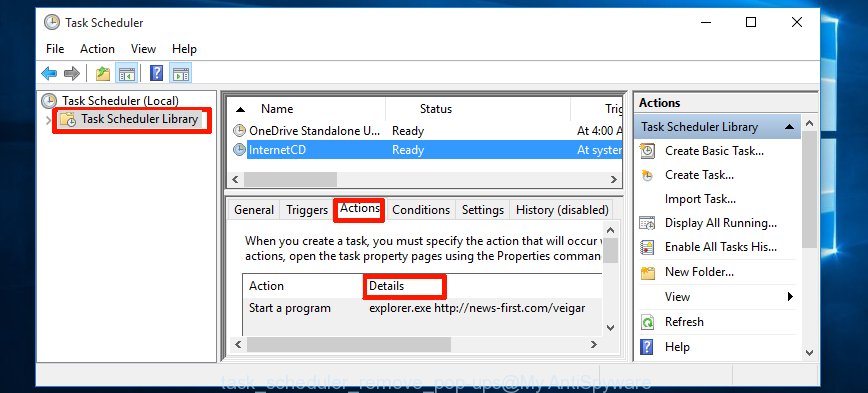
Task scheduler, list of tasks
In the middle part you will see a list of installed tasks. Select the first task, its properties will be display just below automatically. Next, click the Actions tab. Necessary to look at the text which is written under Details. Found something like “explorer.exe http://site.address” or “chrome.exe http://site.address” or “firefox.exe http://site.address”, then you need delete this task. If you are not sure that executes the task, then google it. If it’s a component of the ‘ad-supported’ application, then this task also should be removed.
Further click on it with the right mouse button and select Delete as shown on the image below.

Task scheduler, delete a task
Repeat this step, if you have found a few tasks that have been created by ‘ad-supported’ program. Once is complete, close the Task Scheduler window.
Remove go.ppixelm.com with Malwarebytes
Get rid of go.ppixelm.com pop-ups manually is difficult and often the ad supported software is not completely removed. Therefore, we recommend you to use the Malwarebytes Free which are completely clean your PC system. The Malwarebytes is a reputable malware removal program. It can automatically detect and delete the ‘ad-supported’ software (also known as adware) of the your PC system. Moreover, this free program will help you to get rid of browser hijackers, malware and toolbars that your system may be infected too. You can follow the step-by-step instructions below to remove the go.ppixelm.com annoying completely.
Download Malwarebytes Free from the link below.
327720 downloads
Author: Malwarebytes
Category: Security tools
Update: April 15, 2020
Once downloaded, close all applications and windows on your machine. Open a directory in which you saved it. Double-click on the icon that’s named mb3-setup like below.
![]()
When the install starts, you will see the “Setup wizard” which will help you install Malwarebytes on your PC system.

When installation is complete, you will see window as shown on the screen below.

Now press on the “Scan Now” button for checking your system for the adware which causes the reroute to go.ppixelm.com web page. This task can take some time, so please be patient.
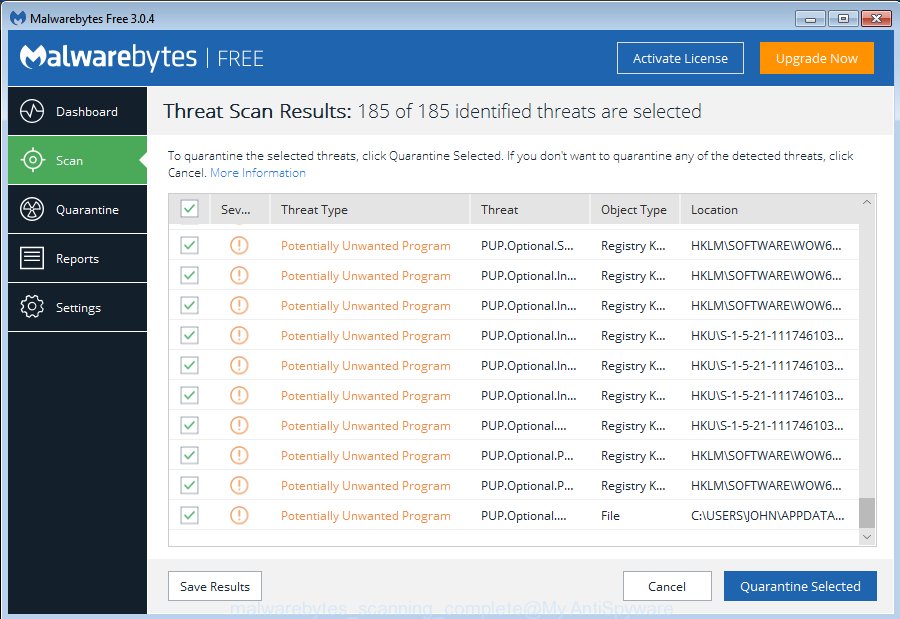
Once the system scan is finished, make sure all entries have “checkmark” and click “Quarantine Selected” button. The Malwarebytes will start removing the adware related files, folders, registry keys. When the disinfection is done, you may be prompted to reboot the computer.
The following video explains the step-by-step instructions above on how to get rid of adware with Malwarebytes Anti-malware.
Block go.ppixelm.com ads and other unwanted web-sites
To increase your security and protect your PC against new unwanted advertisements and malicious web pages, you need to use program that blocks access to dangerous ads and pages. Moreover, the program can block the open of intrusive advertising, that also leads to faster loading of pages and reduce the consumption of web traffic.
Download AdGuard program using the following link.
27036 downloads
Version: 6.4
Author: © Adguard
Category: Security tools
Update: November 15, 2018
Once the download is finished, start the file named adguardInstaller. You will see the “Setup Wizard” screen as shown in the figure below.

Follow the prompts. Once the setup is done, you will see a window as shown on the image below.

You can click “Skip” to close the installation program and use the default settings, or press “Get Started” button to see an quick tutorial that will assist you get to know AdGuard better.
In most cases, the default settings are enough and you do not need to change anything. Each time, when you start your PC system, AdGuard will run automatically and block pop-up ads, web pages such as go.ppixelm.com, as well as other dangerous or misleading sites. For an overview of all the features of the program, or to change its settings you can simply double-click on the AdGuard icon, that is located on your Windows desktop.
Get rid of go.ppixelm.com advertisements and malicious extensions with AdwCleaner.
If MalwareBytes cannot get rid of the unwanted go.ppixelm.com pop-ups from the Chrome, IE, Firefox and MS Edge, then we suggests to use the AdwCleaner. AdwCleaner is a free removal tool for ad-supported software, browser hijackers, PUPs and toolbars.
Download AdwCleaner from the link below.
225788 downloads
Version: 8.4.1
Author: Xplode, MalwareBytes
Category: Security tools
Update: October 5, 2024
After downloading is complete, open the directory in which you saved it. Double click the AdwCleaner icon. Once this utility is started, you will see a screen such as below.
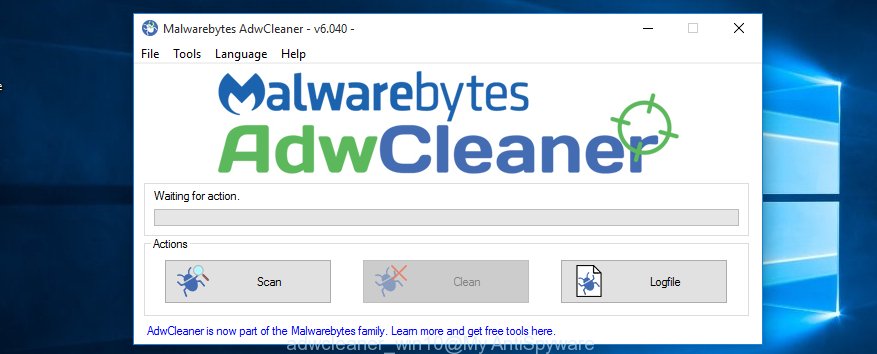
Now, press the “Scan” button for checking your PC system for the malicious extensions and ad supported software which opens ads from go.ppixelm.com web page. Once the scanning is finished, it will open a scan report as shown below.
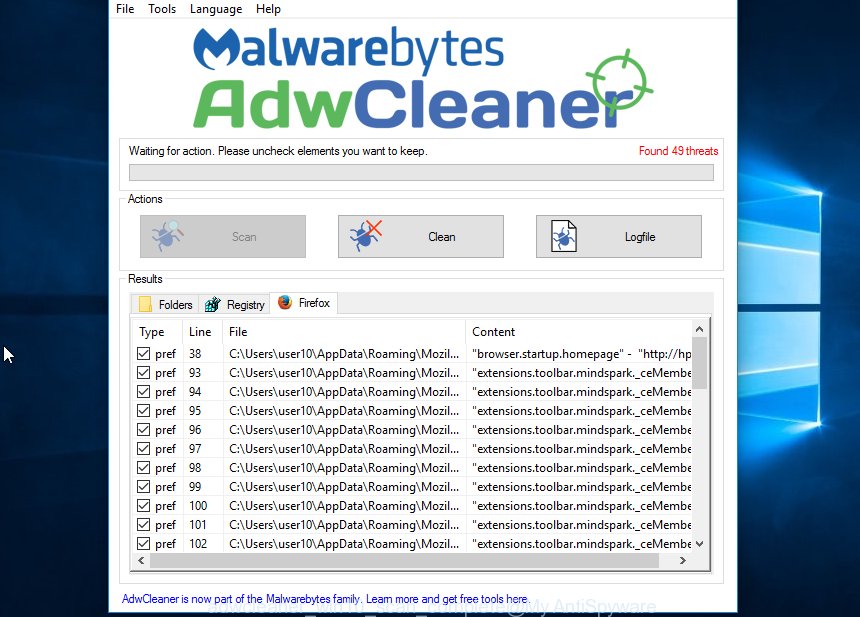
Review the report and then click “Clean” button. It will show a prompt. Click “OK”. When the clean up is finished, AdwCleaner may ask you to restart your computer.
Look at the following video, which completely explains the procedure of using the AdwCleaner to delete adware, browser hijackers and other malicious programs.
Finish words
Now your personal computer should be free of the go.ppixelm.com advertisements. Remove AdwCleaner. We suggest that you keep AdGuard (to help you block unwanted pop-ups and unwanted dangerous web pages) and Malwarebytes (to periodically scan your machine for new malware and ad supported software). Make sure that you have all the Critical Updates recommended for Windows OS. Without regular updates you WILL NOT be protected when new dangerous programs and ad supported software are released.
If you are still having problems while trying to delete go.ppixelm.com from your personal computer, then ask for help in our Spyware/Malware removal forum.

